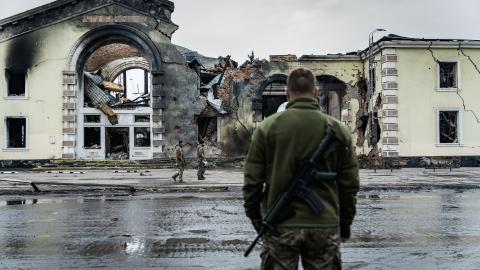We’ve been reading a lot recently about the tragic deaths of migrants in the Mediterranean en route from Libyan ports to Italy—the port of first arrival for the overwhelming majority of migrants—and also about some notably bad ideas for solving the “crisis,” including Italy’s suggestion of putting European Union boots on the ground in Libya and destroying ships in ports there. Libya’s recognized government has rejected these ideas while signaling its willingness to do all it can to help solve the problem.
In fact, just a little digging into the facts shows that politics are playing as big a role as humanitarian concerns.
First and foremost among the bad ideas is the perverse E.U. and U.N. insistence that the way to address the issue is through a Libyan “unity government,” by which they mean bringing together elements from the Islamist Fajr coalition that seized Tripoli last August with the legitimate elected legislature in Tobruk and the cabinet it chose. “As long as there will not be a unity government that will exercise its legitimate authority over the entire territory of the country and its land and sea borders, the situation is likely to continue this way,” E.U. foreign policy head Federica Mogherini declared last month.
Problem is, most of the illegal migration to Europe relying on Libyan boats originates from the western coastal towns of Libya from Misrata to Zwara, with the cooperation of the Taliban-ish Fajr militias controlling these areas who cash in on the traffic. Tobruk, where the recognized legislature sits, is just 194 nautical miles or 360 km from Crete, yet there is no problem with vessels leaving Tobruk packed with migrants heading to Crete.
So the E.U./U.N. approach is like “solving” Mexico’s drug problem by bringing the cartels into the government.
Libya already tried that—it was called the Gaddafi regime. Under Gaddafi, as a 2014 U.S. Institute of Peace report on migration states,-12,798, “the illicit economy was largely state sponsored.” Italian Prime Minister Silvio Berlusconi had warm relations with Gaddafi. So the Italian approach to migration in the Berlusconi years was a bit different. In fact, it involved forcibly returning migrants to Libya without investigating asylum claims.
According to a September 2009 Human Rights Watch report, “Italian patrol boats tow migrant boats from international waters without determining whether some might be refugees, sick or injured, pregnant women, unaccompanied children, or victims of trafficking or other forms of violence against women…. The policy is an open violation of Italy’s legal obligation not to commit refoulement-the forced return of people to places where their lives or freedom would be threatened or where they would face a risk of torture or inhuman and degrading treatment.” The full report is well worth reading.
So, because Gaddafi’s minions had their fingers in the smuggling pie, and Gaddafi was pals with Berlusconi, Italy was not asking the E.U. to put boots on the ground in Libya or destroy fishing boats to stop the human trafficking.
Reading news reports, one might have the impression that the number of migrants to Italy has increased dramatically in 2015, but this is only true of recent weeks, after the E.U. announced new rescue efforts (and threatened a crackdown on smugglers’ boats). Just last weekend, more than 5,000 were rescued, bringing the total this year to upwards of 40,000.
But until May the numbers in 2015 were running well below the 35,000 for the first five months of 2011 when the Gaddafi regime wobbled and Libya’s borders became more porous.
About 26,000 migrated by sea in the first five months of 2014, according to the International Organization for Migration But in 2006, even when the Gaddafi regime was firmly in control, 22,000 people arrived in Italy by boat from North Africa, and 19,900 in 2007
There has been a migrant crisis in 2015—but of deaths, not of absolute migrant numbers. More than 1,800 migrants have died in 2015 to date.
The terrible death rate in 2015 is due to many factors, including the suspension in October of Italy’s Mare Nostrum search and rescue program which covered a much wider area of the Mediterranean than that now patrolled by what’s called Frontex; the switch by some traffickers to using plastic Zodiacs rather than sturdier wooden fishing boats; and the fact that many migrants are no longer supplied by traffickers with life jackets. (Nice folks.)
Of course, all of this begs the question of why tens of thousands of Africans think it worth a more than 4 percent risk of death to escape their home countries, and why the world won’t pressure governments like Eritrea—the single largest source of migrants as of the end of April—as well as Ethiopia, Somalia, Nigeria and Gambia to improve conditions Not to mention Syria. But it’s easier for the E.U. and U.N. to pretend that the citizens of these tyrannical, corrupt or failed states have a right to become citizens of the E.U. than to deal with their rights under the U.N. Charter to have a decent, free life in their home countries.
Until the E.U. and U.N. are able to identify and punish the real culprits for the tragic deaths in the Mediterranean—ranging from Syria’s Bashar al-Assad to the rulers of the Sub-Saharan African countries that most of the migrants flee, to the Islamist militias that fund their reign of terror in Libya by human trafficking—it is unlikely that there will be any solution to this problem. And until the west coast of Libya as well as the east is governed responsibly, the human traffickers will continue to prey on these desperate refugees.
















